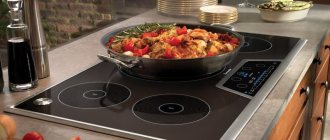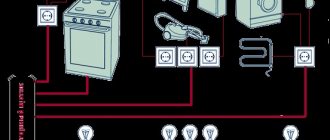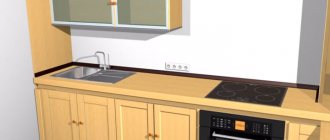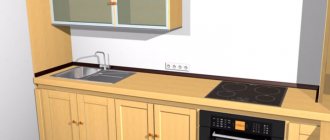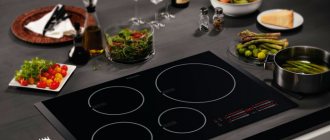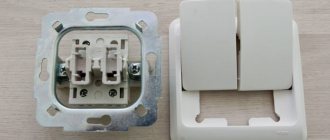This review analyzes the advantages of existing models of hobs. Methods of their installation and methods of connecting to the electrical network are described. Let's evaluate the advantages of each panel when choosing a product. After receiving installation information, we will select the most convenient way to connect the hob at home, guided by the technical parameters of the kitchen.
There are many types of hobs with different nuances in their connection Source faqindecor.com
What are hobs?
Before we study connecting the hob to the electrical network, let’s get acquainted with its varieties. Built-in hobs are rectangular or hexagonal in shape, their width is 250 – 900 mm, their depth is 600 mm.
A beautiful panel pleases the hostess’s eye Source www.hotelresidencia.com
The manufacturing material is focused on various preferences and financial status of the consumer:
- Aluminum . Such devices require daily monitoring. They are very user friendly. These devices have an affordable price and withstand mechanical and thermal stress. The material is impact resistant but sensitive to scratches.
- Enameled . Their main advantage is their reasonable price. Enameled devices are available in a wide range of colors. They, unlike aluminum ones, do not show fingerprints. The disadvantage is the heaviness of the product, which does not always suit the parameters of the mounting surface.
- Stainless steel . These models are more expensive than enamel and aluminum. Reliable and durable. The downside is that fingerprints and water marks remain visible.
- Built-in glass-ceramic hob . Modern models with touch control. They have a stylish design and are easy to use. This material heats up and cools instantly. The only disadvantage is that glass ceramics is fragile and susceptible to cracks. Cold water sometimes causes chips due to impact on a hot surface.
The problem of choosing hobs
Choosing a product on the market is difficult due to the lack of suitable types. After all, the type of installation of the hob depends on the parameters of the selected model.
Hob: view after installation Source tehznatok.com
Main product classification:
- Products are gas , electric and induction . As for the electric panel, this is the best option for a house where gas is not installed. If the buyer's first priority is comfort, experts recommend purchasing a gas appliance. The induction hob is characterized by a modern set of advantages.
- Dependent panel . A dependent model is a model produced together with the oven. In this case, the oven is located inside the kitchen unit or is integral with the hob. The combination of oven and hob does not always happen, even if they are manufactured by the same company.
- Independent model . It is not connected to the oven. The main advantage of such units is the arbitrary location of the device in the kitchen. The dependent model is made so that it can be placed exclusively above the oven.
Differences by type of control:
- Mechanical mode of operation requires a rotating mechanism. Most consumers prefer this type.
- Touch models work with a light touch of your hand. This is a truly innovative method. Cleaning the panel is easy because the surface is smooth.
The main rule when choosing is security parameters. Source m.sm-shop24.ru
General rules and requirements
There will be no connection yet depending on what kind of panel you are working with, gas, electric or induction. Nowadays induction panels are very popular, although they have a number of nuances.
Regardless of the type of panel, the rules are common to all. They sound like this:
- Be sure to provide a ventilation system
. This is for safety as well as hygiene reasons. Install the hood. If this is not possible, then place a fan on the window; - Heat resistance and thickness
. You can choose any tabletop option. But the instructions stipulate that the heat resistance should not fall below 100 degrees Celsius. This fact places additional requirements on thickness. It is not always possible to fit a panel into a thin tabletop. Recommended thickness is 25 mm or more; - If installation is carried out between 2 cabinets
. Here you will need to maintain a distance of at least 15 cm from the wall, as well as from each cabinet to the stove. The requirements for kitchen walls are slightly lower. But you shouldn’t cross the 5 cm threshold. For greater safety, you can use thermal insulation material.
But these are general rules for those who plan to install a hob.
How to install a panel into a countertop
Independent connection of the surface first requires proper installation of the panel into the prepared cutout of the kitchen unit.
Installation is carried out in several stages:
- We determine the future location . Dimensions are determined with a ruler. It is most convenient to use a cardboard blank.
- Draw the shape of the panel on the board. A maximum of 1 mm can be left to allow the product to easily enter the panel.
- Drilling panel borders . Pre-drill in the corners of the marked shape. Diameter 9-10 mm. The drill must be made of wood or metal.
- The next step in installing the hob into the countertop is to cut a hole using a jigsaw. The tool is inserted into the finished hole, pressed firmly against the board, and then begin the cutting process. In this case, the brush should be pressed along the marking lines at low speed.
- Attach it securely to the top of the table using a set of clamps. Then remove the remaining wood.
- The remaining gap must be filled with special silicone sealant .
The process of installing a gas panel Source stroy-podskazka.ru
After installing the device in the set, you can begin the process of connecting it to the electrical network.
See also: Catalog of flat roof house projects
Working conditions
In an apartment, the installation location of the gas panel is determined by the location of the gas pipe. A shut-off valve must be installed on the gas pipe. It is worth noting that moving a gas pipe over any distance should only be done by gas company specialists. At the same time, no one forbids installing a gas panel at a certain distance from the pipe, using a flexible gas supply (gas hose).
bellows hose, flexible gas connection
Connection Tips
The process itself - how to connect the hob to the mains - is quite simple. You will need the following tools and components:
- An impact drill that is attached to a drill bit of a specific size to drill into a wall.
- Plastic inserts.
- Mounting screws for container.
- Screws for mounting the socket.
- Screwdriver.
- Knife to clean the ends of the crimp wires.
- Insulating tape.
Safe installation of the hob Source my-muzh.ru
In general, the plan for how to install the hob safely and independently should look like this:
- The connectors can be connected directly through the plate terminals. To access them, disconnect the cover on the back surface and remove the safety device.
- We focus on the color marking of the wires and the shade of the connected terminals. A single-phase network requires the use of a red wire with a membrane.
- Using a plug with a grounding terminal requires connecting the green/yellow wire.
A competent and secure connection first requires information about the parameters of the network connected to your home. Based on these technical parameters, the connection algorithm is selected.
Marking
Inserting a hob begins with finding out the dimensions and applying them to the countertop. As a rule, the parameters are indicated in the instructions supplied with the equipment. If the manufacturer did not take care of this, then it is possible to calculate everything independently. In the first option, the panel is turned over, after which it is traced on thick cardboard or even directly on the tabletop. For this you will need a ruler of sufficient length, a pencil and a marker.
You can try to determine the mounting location yourself. First, the boundaries of the interior space of the cabinet, on which the panel itself will be placed, are transferred to the surface with a pencil. By the way, when a pencil does not allow you to apply bright markings, then it is wise to first glue masking tape and then draw. Next, the center of the hole for the housing is determined. To do this, it will be enough to draw the diagonals of the rectangle, which are created by the front and back parts of the tabletop, and the drawn boundaries of the cabinet.
At the point where the diagonals intersect, two lines are drawn to form a cross. This means that one should run parallel to the edge of the tabletop, and the second should be perpendicular to it. The dimensions of the part of the body that should be built-in are marked on the lines that appear. The exact numbers are either determined independently or extracted from the instructions. It is better, by the way, to increase them by a centimeter or two for greater convenience.
If parallel and perpendicular lines are drawn through the resulting marks, a rectangle is formed. Not only will it be exactly in the center, but it will also coincide with the part of the hob that needs to go deeper. If the gap prescribed by the manufacturer remains between the formed lines and other objects, then you can outline the figure with a marker and move on to the next stage.
Algorithm for connecting the panel to single-phase networks
This option is possible if a wire of three cores is embedded in the wall.
Scheme for connecting the panel to single-phase networks Source rolexforum.ru
To install the panel, the following steps are required.
- Use a screwdriver to unscrew the plate located behind the panel.
- Use jumpers to connect the first, second and third terminals. The phase connection is carried out using a brown, black or white wire
- We connect the blue wire to the zeros. These are numbers four and five.
- Cables for hobs are connected to the protective terminal (yellow).
- Tighten the mounting screws.
- It is necessary to check the reliability and tightness of connections and the functioning of the product.
The preliminary stage of connection is to check the technical condition of the sockets. If necessary, replace it.
See also: Catalog of companies that specialize in electrical work
Window cutout for panel installation
After making sure that the markings are correct, you can begin cutting out the hole. Using a drill with a diameter 2 mm larger than the width of the jigsaw file used, drill 4 holes in the inner corners of the drawn contour. Insert a jigsaw blade into one of the holes and make a cut in the tabletop along the entire contour. To prevent large chips, you need to use a fine-toothed file or a hand router.
Place the panel to be installed into the resulting niche and align it. See from the outside whether everything is done smoothly. If everything is done correctly, proceed to the next stage of cutting into the tabletop . Now treat the cut areas with sandpaper, a file, or a rasp. If the countertop used is made of wood, be sure to exclude the possibility of moisture penetration. To do this, carefully treat the cut area with moisture-proof material:
- silicone;
- sealant;
- nitro lacquer
If the countertop is made of plastic materials, this treatment can be skipped. The plastic will not swell or swell due to moisture. Can be coated in several layers for reliability. After the last layer has dried, cover the cut with self-adhesive sealant. Preparations are complete. Installation can be done.
How the hob is connected to three-phase networks
Connecting the product to an outlet requires the use of a five-core wire.
Structurally, it consists of:
- three phases;
- grounding intended for protection;
- "zero".
Connection diagram of a panel with three phases Source rolexforum.ru
The process of connecting the hob is as follows:
- We connect a single-phase wire (black or white or shade) to the first terminal, another to number 2, and the rest to the third.
- The fourth and fifth terminals are connected with a jumper, and a blue neutral conductor is connected to them.
- Grounding requires connecting a yellow-green wire.
About the power of the panel and the electrical outlet for it
The Gefest hob, which according to the manufacturer's documents is called a built-in electric household table, with all burners turned on, consumes 5-5.5 kW of electrical energy. Panel power 220-230 volts. You can calculate for yourself that at maximum operating mode, the electric current in the panel’s power circuit will be 5500÷220=25 Amperes.
We use the table for calculating the cross-section of the electrical cable and the current strength of the circuit, we see that for this mode you need a cable (copper) with a core cross-section of at least 2.5 mm2. Or aluminum wires (cable cores) with a cross section of 4 mm2.
In my version, the house was not new, and the wiring in it was “original” in excellent condition, but made of aluminum. No one planned to change the wiring, so we limited ourselves to a visual inspection and replacement of the circuit breaker for the stove's power supply group. The wiring for the stove is separate with a grounding wire, which fully complies with the rules of the PUE.
Installing the hob plug
If the device is equipped with a cable, where the plug is connected, and there is a suitable outlet in the room, then all that remains is to turn on the product.
In another case, it is necessary to carry out a certain algorithm of actions:
- The plug is pre-disassembled and the cable is passed through the prepared hole.
- We connect the brown and blue wires to the plug outputs.
- If o and “N” are present on them, then the brown wire is connected to the terminal with the letter “L”, and accordingly “N” receives a blue cable.
- The yellow-green wire is attached to the central terminal of the plug.
- The plug is assembled together and secured with a bolt.
Connection of wires in a plug Source cable.ru
Gas hob connection diagram
Once a gas stove has been selected, it is not difficult to connect it, provided that a similar unit has been used in this kitchen before. The gas hob must be connected using a flexible hose.
Example of a gas hob Source t10p.ru
The main safety requirement is to turn off the gas tap at the entrance to the apartment before starting the connection.
All modern gas surfaces are equipped with electric ignition.
Algorithm for how to connect a gas hob:
- Black and brown wires are attached in the plug to the terminal responsible for the phase.
- The blue wire is connected to the connector responsible for “zero”.
- The yellow-green colored cable is connected to ground in the central part of the plug.
- We check the functioning of the ignition in the gas hob.
Gas device installation:
- Installation is carried out in the workbench after cutting out a rectangle of the required size using a penetrating saw.
- It is advisable to leave a gap between the panel and the wall of about 5-6 cm for ease of installation of auxiliary communications.
View of the connected gas panel from below Source kuhnyamy.ru
Measurements
Before purchasing a panel, you need to know the width of the tabletop. The dimensions of most panels are standard and do not go beyond 55-57 cm. The documentation for the panel must indicate not only the dimensions of the panel, but also the size of the hole in the countertop for installing the panel.
Panel installation diagram
Related article: History of the electric stove and hobs
Connecting induction panels
Such plates are economical and efficient. Using the induction unit, only the bottom of the pan is heated, while the surface itself remains cold. Surfaces with this type of heating are the most expensive on the market.
Induction hob - a stylish and modern device in the kitchen Source tehnikaportal.ru
To connect an induction hob, you need to go through a certain algorithm of actions.
- There are two types of electrical cords. To connect the stove, you only need to buy the wire that is suitable for the wiring of your home.
- Now you need to open the cover on the back side of the surface. Here you should find a small rectangle. It needs to be dismantled.
- Opening the cover, we find the necessary terminals. We pre-mount the wires into the clamps. They must be securely tightened. This securely holds the cable out of the box.
- The next step is to remove the copper plate. The old style induction cooker has three cores. The modern model boasts 4 cores. The neutral entrance is in the middle. Phase holes are located on the sides. The ground terminal can be found at the bottom.
- It is necessary to establish a reliable connection between the wires and terminals. To install them, unscrew the fasteners and insert the end of the wire into the hole. Grounding is pre-connected. At the next stage, “zero” is added. The final step is to connect the phase holes.
How to connect induction panels Source mekelektro.ru
- The copper element is installed between the phase terminals.
- Be sure to check the strength of all connections.
- After the connection process, we check the operation of the device by turning it on.
When connecting, the electrical factor comes first. The surface heats up in a matter of seconds, so the burners can immediately begin their functions, creating comfortable use
The disadvantages of such panels include large electricity consumption. Consequently, connecting a hob imposes certain safety requirements when carrying out the described work.
Electrical cable for connection
First of all, understand that the hob must be connected with a separate electrical wiring line directly from the switchboard. It is not allowed to power it from an existing common distribution box in the kitchen or from already installed sockets.
The cable must be three-core and copper, and it’s up to you to decide which brand VVGnG-Ls or NYM. Which cable is better and how they differ can be read in detail in the article “4 differences between NYM and VVGnG-Ls”.
The most important thing is to choose the right section. The set of rules SP31-110-2003, compiled on the basis of GOST and PUE, states that for slabs it is necessary to select a cross-section of at least 6mm2.
But apparently, here we are talking about preliminary installation of wiring in the apartment, when it is not yet known what power the hob will be installed. Therefore, initially a cross-section of 6 mm2 should be provided, sufficient to connect most existing models.
If your power is less than 7 kW, and you are sure that in the future you will not buy a new, more energy-intensive stove, then you can use the following table as a guide:
What should you do if the cable has already been laid (VVGng-Ls 3*2.5mm2), but it turns out to have a smaller cross-section than needed for the maximum possible power of the hob (7.2 kW). At the same time, there is neither the opportunity nor the desire to re-drill the walls.
In this case, you can protect yourself in two ways, although you will have to come to terms with the fact that you will not be able to use the full power of the panel:
- install a switch in the panel based on the nominal cross-section of the cable, and not the power of the stove (see the table above, according to the cross-section)
- programmatically set the panel operating mode in which it will not be possible to turn on all burners at the same time
That is, if you don’t yet know what kind of hob you will have, feel free to use 6mm2. Just keep in mind that low-power panels have small terminal blocks that are not designed for 6mm2. And it is not always convenient to connect such a wire directly; you can break the clamp.

